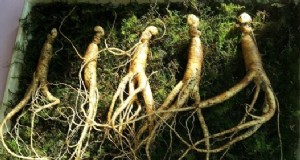INTRODUÇÃO À AGRICULTURA DE ESPECIARIAS:
Cultivo de especiarias:a especiaria é uma substância que é usada em alimentos com o propósito de dar sabor, cor ou preservação. Especiarias diferentes são obtidas a partir de diferentes partes de uma planta ou árvore, como sementes, latidos, raízes e frutos. Espera-se que algumas especiarias tenham propriedades antimicrobianas e antibacterianas. O uso de algumas especiarias é encontrado em cosméticos, rituais religiosos, medicamentos e perfumes. Diferentes especiarias são consideradas originárias de diferentes países do mundo. Canela e pimenta-do-reino são originárias do Sul da Ásia e do Oriente Médio, cravo durante a civilização mesopotâmica, noz-moscada das ilhas Banda, no sudeste da Ásia. A demanda por especiarias era maior na Europa durante a meia-idade. Durante este período, especiarias foram importadas da Ásia e da África. No período moderno, havia uma grande demanda pelo mercado de pimenta na Índia. O principal problema com especiarias hoje em dia é a diluição. A qualidade das especiarias tornou-se inferior devido à adulteração (mistura de outros produtos indesejados na mistura original).
Diferentes formas de especiarias são frescas, seco e em pó. As especiarias estão geralmente disponíveis em sua forma seca para maior usabilidade e maior vida útil. Existem algumas especiarias que quando usadas frescas dão mais essência do que as secas como o gengibre. Especiarias como a cúrcuma são sempre usadas na forma de pó. Especiarias como erva-doce e mostarda são usadas inteiras ou em pó. O sabor de um tempero é perdido quando exposto ao ar devido à oxidação e evaporação. Então, É altamente recomendável que as especiarias sejam armazenadas inteiras e moídas quando necessário, para obter o máximo sabor. Os temperos usados para cozinhar são adicionados no início da preparação para que o sabor seja infundido na comida, ao contrário das ervas que são adicionadas no final da preparação.
 Práticas de cultivo de especiarias.
Práticas de cultivo de especiarias. Espera-se que os temperos contenham calorias, porção de gordura, carboidratos, minerais, micronutrientes e proteínas. Cominho e gengibre apresentam alta propriedade antioxidante que ajuda como conservantes naturais.
As especiarias são contaminadas por uma bactéria chamada salmonela. Algumas dessas bactérias são resistentes a antibióticos e agora são tratadas usando o método de esterilização por radiação.
AGRICULTURA DE ESPECIARIAS TURMÉRICAS:
 Açafrão.
Açafrão. - INTRODUÇÃO: O nome binomial da cúrcuma é Curcuma longa e pertence à família do gengibre. É considerado o nativo do subcontinente indiano. Este é um rizoma usado na forma de pó seco. Tem propriedades medicinais, por isso é usado para tratamentos antibacterianos. Tem uma cor amarela e um aroma agradável.
- CONDIÇÕES CLIMÁTICAS E DO SOLO PARA A AGRICULTURA DE ESPECIARIAS TURMÉRICAS: Solo argiloso e arenoso, com alto teor de húmus e bem drenado, é usado para o cultivo de açafrão. É cultivado ao nível do mar ou em um elevação de 1500 m acima do nível do mar. A temperatura da região é estimada em 20-30 graus Celsius e a média precipitação deve ser em torno de 1500-2250 mm
- PROPAGAÇÃO: A cúrcuma é propagada por meio de estacas de rizoma que são plantadas durante o final do inverno.
- PREPARAÇÃO E PLANTIO DE TERRAS: poços de 3 polegadas de profundidade são feitos usando uma enxada manual e o o espaçamento da linha é de 25 cm x 30 cm . Estes são cobertos com solo e esterco de gado seco. Cumes e sulcos são espaçados em um distância de 45-60 cm entre as linhas e espaçados de 25 cm para plantas.
- ADUBAÇÃO E IRRIGAÇÃO: Estrume de gado @ 40 toneladas / ha é usado extensivamente para cultivo de açafrão. Uma vez que esta planta é do tipo irrigação, Isso requer 15-20 ciclos para solos pesados e 35-40 ciclos para solos leves. FYM @ 10 toneladas / ha é necessário para o curativo basal. A ração de N:P:K é 125:37:37 kg / ha.
- A cobertura morta é feita duas vezes com palha de cana ou verde folhas @ 12-15 toneladas / ha em um intervalo de 50 dias.
- GESTÃO DE DOENÇAS: broca de broto é controlada por pulverizando Malathion 0,1% . A escala do rizoma é controlada mergulhando os rizomas em quinalphos 0,1% antes do plantio. A podridão do rizoma é controlada usando ditano M-45 0,3% durante o preparo do solo. A mancha da folha é controlada por pulverização de 0,2% de ditano M-45 .
- COLHEITA E PROCESSAMENTO: a colheita é feita após 10 meses do plantio, quando o rizoma amadurece. O clima quente é bom para açafrão, portanto, se semeado em outubro, é colhido em agosto. Os rizomas são fervidos até ficarem macios e secos ao sol, espalhados em esteiras de bambu por 15 dias aproximadamente.
- PRODUÇÃO: Em média, um acre de terra rende de 8 a 10 toneladas de açafrão.
AGRICULTURA DE ESPECIARIAS DA FOLHA DE BAY:
 Folha de louro.
Folha de louro. - INTRODUÇÃO: Folha de louro (nome binomial:Laurus nobilis). É originário do Mediterrâneo e atinge uma altura de 12 metros. As plantas têm folhas verdes de tamanho médio. É utilizado como agente aromatizante e também como medicamento.
- CONDIÇÕES CLIMÁTICAS E DO SOLO PARA A AGRICULTURA DE ESPECIARIAS DE BAY LEAF: A luz solar é uma condição requintada e o vento frio ou a geada podem ser prejudiciais. O clima favorável é clima mediterrâneo quente e úmido. Solo bem drenado com matéria orgânica suficiente é altamente adequado com um faixa de pH de 6-8.
- PROPAGAÇÃO: Brotos em camadas ou estacas de raiz são usados para a propagação da folha de louro.
- PREPARAÇÃO E PLANTIO DE TERRAS: A terra é suplementada com esterco de curral e as ervas daninhas são removidas com aração.
- ADUBAÇÃO E IRRIGAÇÃO: O estrume podre do quintal da fazenda é útil para aumentar a riqueza do solo. O abastecimento adequado de água é fornecido por meio de irrigação por gotejamento para manter a umidade do solo intacta.
- GESTÃO DE DOENÇAS: Ácaros, pulgões e escamas duras são pragas que infectam a árvore e são controlados pela aplicação de óleo de nim. O spray de enxofre evita manchas pretas e danos às folhas.
- COLHEITA E PROCESSAMENTO: Por ser uma variedade perene, as folhas estão disponíveis durante todo o ano para a colheita. Geralmente, eles estão secos antes do uso.
- PRODUÇÃO: Um hectare de terra produz 6 toneladas de folhas.
AGRICULTURA DE ESPECIARIAS DE NOZMEG E MACE:
- INTRODUÇÃO: noz-moscada e maça são produtos da mesma árvore (nome botânico:Myristica fragrans houtt). Esta árvore é nativa da Indonésia e agora é cultivada em algumas partes da Índia. É uma árvore perene, densamente foliada, que atinge os 20m de altura. Essas especiarias são usadas em condimentos alimentares, perfumes, preparação de óleos e manteigas.
- CONDIÇÕES CLIMÁTICAS E DO SOLO PARA A AGRICULTURA DE ESPECIARIAS NOZMEGAS: caloroso, clima úmido com chuvas anuais de 150 cm é necessário para essas árvores. A área ideal é a partir do nível do mar a 1300 m acima do nível do mar. As encostas dos Gates ocidentais e orientais são uma boa escolha para o cultivo de noz-moscada e macis. Solo com argila, argila, areia e laterita vermelha são adequadas para esta árvore.
- PROPAGAÇÃO: A semente dos frutos desta árvore é usada para propagação. Camadas de ar e brotamento também são métodos bem-sucedidos de propagação, mas a técnica de 'enxerto de epicótilo' é o mais produtivo.
- PREPARAÇÃO E PLANTIO DE TERRAS: quando as mudas crescem, depois de 12 a 18 meses eles são transplantados para a área principal. Covas cúbicas com dimensões de 60 cm são cavadas e preenchidas com solo superficial e composto. O espaçamento entre os poços é 8 m x 8 m . O plantio é feito na época das chuvas. A sombra é necessária durante os primeiros anos. A cobertura morta é feita com lixo disponível nas redondezas.
- ADUBAÇÃO E IRRIGAÇÃO: A árvore requer grande quantidade de estrume para maior rendimento e crescimento. FYM @ 10 kg / planta é usado no primeiro ano. Uma árvore de 15 anos exigiria cerca de 50 kg de estrume. Nitrogênio @ 20 gramas, fósforo a 18 gramas e potássio a 50 gramas são aplicados a cada planta no primeiro ano. A dose aumenta com a idade da árvore e é aplicada duas vezes ao ano; Maio-junho e setembro-outubro. A irrigação não é muito necessária.
- GESTÃO DE DOENÇAS: O die back causado por diplodianatalensis é controlado pela aplicação de mistura de bordeaux nas pontas dos ramos. A luz da linha é causada por Marasmius sp. é controlada pela pulverização de 1% da mistura bordalesa. A podridão dos frutos é causada por Phytophthora e Diplodia natalensis, que é controlada por pulverização 1% de Bordéus
- COLHEITA E PROCESSAMENTO: Se as mudas forem usadas, o rolamento começa em 7-8 anos, mas se o enxerto for feito, o rolamento começa em 4-5 anos. O rolamento total é obtido após 15-20 anos e rende até 60 anos. A colheita é feita de junho a agosto. O amadurecimento do fruto é conhecido quando a casca carnuda se abre. A maça é separada da noz e seca lentamente ao sol por 10-15 dias. A semente também é seca separadamente por 4-8 semanas ao sol ou por processos artificiais. A casca externa é removida e a porca é removida.
- PRODUÇÃO: A produção média de uma única árvore é de 2.000 a 3.000 frutos por ano. Espera-se que um hectare de terra possa produzir 800 kg de noz-moscada e 100 kg de macis.
AGRICULTURA DE ESPECIARIAS DE ANIS ESTRELAS:
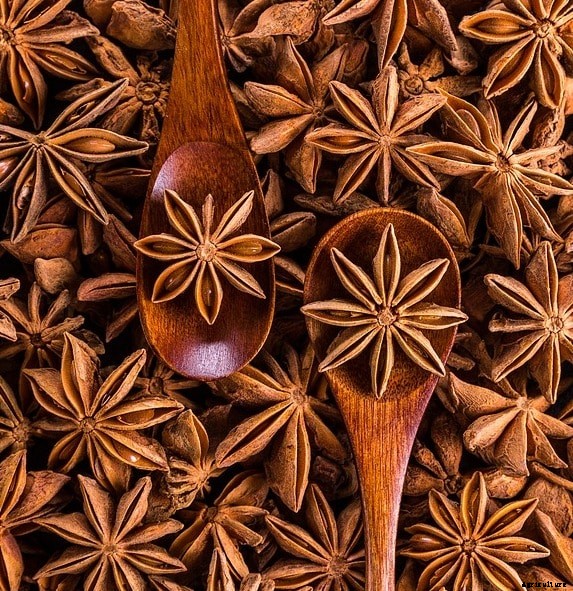 Anis estrelado.
Anis estrelado. - INTRODUÇÃO: Esta especiaria recebe o nome de sua forma. Seu nome botânico é Illicium verum. A Sibéria é considerada ideal para o cultivo de erva-doce. Esta é uma especiaria de cor castanha escura com aroma forte. Isso também é chamado de anis e tem propriedades medicinais. É uma árvore perene e atinge uma altura de 5 a 10 m.
- CONDIÇÕES CLIMÁTICAS E DO SOLO PARA A AGRICULTURA DE ESPECIARIAS DE ANIS ESTRELA: Solo rico em húmus ou solo ligeiramente ácido é mais adequado para o cultivo de anis. Requer clima subtropical onde a temperatura não seja inferior a -10 graus Celsius. A planta precisa de um clima quente e ensolarado, onde não haja ventos secos ou frios. O PH do solo é 6-6,7.
- PROPAGAÇÃO: A propagação é feita semeando sementes ou estacas diretamente. A temperatura de propagação é de 18-20 graus Celsius.
- PREPARAÇÃO E PLANTIO DE TERRAS: Mudas de 6 semanas de idade são semeadas com espaçamento de 12 polegadas . Cada linha é separada por 18-24 polegadas . O plantio é feito na primavera.
- ADUBAÇÃO E IRRIGAÇÃO: Manter a umidade adequada é o suficiente. Muito pouca irrigação é necessária no inverno. Espalhar uma camada de 3 polegadas de composto ao redor da árvore é o melhor fertilizante. Às vezes, para maior rendimento e qualidade, um sintético Fertilizante NPK ou Bactofil B-10 e slavol (biofertilizantes) são usados.
- GESTÃO DE DOENÇAS: uma vez que é uma variedade antibacteriana e repelente de pragas, portanto, não é necessário muito para tratar doenças dessas plantas.
- COLHEITA E PROCESSAMENTO: A árvore requer 6 anos para dar frutos quando é cultivada a partir de sementes. Os frutos são apanhados quando maduros e secos ao sol até mudarem de cor de verde para castanho avermelhado.
- PRODUÇÃO: Em condições favoráveis, o rendimento médio dos frutos desta árvore é de 1551 kg / ha.
GREATER CARDAMOM SPICE AGRICULTURA:
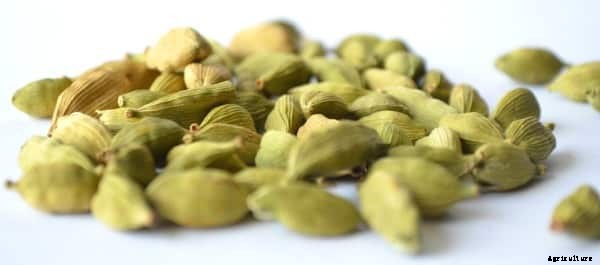 Cardamomo.
Cardamomo. - INTRODUÇÃO: Isso também é chamado de cardamomo preto e seu nome binomial é Amomum subulatum. As vagens têm forte aroma a fumaça e são usadas como especiarias. O maior produto é do Nepal. Ele também tem usos medicinais, como tratamento de icterícia.
- CONDIÇÕES DO SOLO E CLIMÁTICAS: Esta especiaria é cultivada em elevações de 1000-2000 acima do nível médio do mar. Requer uma precipitação média anual de 3000-3500 mm . Profundo, solo argiloso bem drenado é bom para essas plantas. O pH do solo deve ser mantido em 4.5-6.
- PROPAGAÇÃO: A propagação desta planta é feita vegetativamente através de rizomas ou por sementes. Rizomas de plantas cultivadas são retirados e processados em grupos menores e plantados em covas.
- PREPARAÇÃO E PLANTIO DE TERRAS: Inclinação moderada para o cultivo desta planta é considerada. Poços de dimensões 30 x 30 x 30 cm são cavados com espaçamento de 5 x 1,5 m entre cada poço durante a monção. Os poços são cobertos com solo superficial e composto. As mudas são plantadas no centro da cova e a cobertura morta é feita com folhas secas na base da planta.
- ADUBAÇÃO E IRRIGAÇÃO: Estrume de gado e bolos de óleo não comestíveis usados como estrume. Melhor irrigação proporciona maior rendimento. A irrigação por aspersão é usada dependendo da necessidade.
- GESTÃO DE DOENÇAS: Doenças fúngicas e bacterianas podem ocorrer nesta planta. As duas principais ameaças a esta planta são Chirke e Foorkey.
- COLHEITA E PROCESSAMENTO: quando a semente de uma cápsula fica marrom, os perfilhos são cortados 30-35 cm e podem amadurecer por Mais 10-15 A colheita é feita por um equipamento denominado ‘ Elaichichurri ’ e os espinhos estão empilhados. As cápsulas são separadas e secas. O cálice é removido esfregando a cápsula em um fio.
- PRODUÇÃO: A estimativa mostra que um acre de terra gera 2.000 kg de cardamomo seco.
AGRICULTURA DE ESPECIARIAS DE CARDAMOM MENOS:
- INTRODUÇÃO: Esta especiaria é nativa do subcontinente indiano e é a especiaria mais necessária de toda a lista. É uma planta perene encontrada nos Gates Ocidentais. O nome binomial desta especiaria é Elettaria Cardamomum L. A altura máxima desta planta é de 2 a 4 metros e as variedades encontradas na Índia são Mysore, Tipo Malabar e vazhukka.
- CONDIÇÕES CLIMÁTICAS E DO SOLO PARA A AGRICULTURA DE ESPECIARIAS DE CARDAMOMA: A temperatura ideal e a precipitação necessária para o cultivo de especiarias de cardamomo menos é a 10-35 graus Celsius e 1500-4000 mm precipitação anual, respectivamente. Solo argiloso preto com húmus rico, especialmente no cinturão da floresta, é mais adequado para o cultivo desta especiaria. Solo arenoso não é preferido de forma alguma.
- PROPAGAÇÃO: Sementes ou rebentos são usados para propagação. Essas sementes são cultivadas em viveiros e plantadas na área principal em condições adequadas.
- PREPARAÇÃO E PLANTIO DE TERRAS: Poços de 45 cm x 45 cm x 30 cm são escavados durante abril-maio e são preenchidos com composto e solo superficial. O plantio é feito ao longo dos contornos de uma encosta com espaçamento de 2 m x 1 m . O início da monção é ideal para o plantio dessas sementes e elas são transplantadas no verão para a área principal com espaçamento de 20cm x20cm . A sombra é fornecida e a água é fornecida regularmente.
- ADUBAÇÃO E IRRIGAÇÃO: Nitrogênio @ 90 gramas, fósforo @ 60 gramas e potássio @ 120 gramas são necessários para um tamanho de leito de 5 m x 1 m. Essa dose é fornecida em três parcelas com intervalo de 45 dias entre cada uma. O conteúdo de fertilizante usado para esta cultura é nitrogênio @ 75 kg, fósforo @ 75 kg e potássio @ 150 kg por hectare se está sendo irrigado por fontes externas, mas se os campos são irrigados pela chuva, a proporção de fertilizantes usada é 30:60:30 kg / ha. O fertilizante total é aplicado parcelado e aplicado duas vezes:uma em maio e outra em setembro. 30 cm ao redor da planta os fertilizantes são aplicados. A irrigação é altamente necessária durante a formação da panícula, floração e formação de frutos. Até a chegada da irrigação das monções é feita em um intervalo de 10-15 dias.
- GESTÃO DE DOENÇAS: O tripes e a broca são controlados pela pulverização de monocrotofos 0,025% (março a setembro). Pulgões são controlados pela pulverização de 0,05% de dimetoato. Os nemátodos parasitas são controlados tratando as plantas com carbofurano 3g @ 5kg a.i / ha. A podridão da cápsula é controlada por pulverização 1% Bordeaux A podridão do rizoma é controlada tratando o solo com 0,2% de oxicloreto de cobre .
- COLHEITA E PROCESSAMENTO: As plantas começam a dar frutos logo após dois anos de plantio. A colheita é feita durante o período de outubro a novembro. Os frutos colhidos são secos em secador elétrico a temperatura de 45-50 graus por aproximadamente 14-18 horas .
- PRODUÇÃO: Estima-se que um hectare de terra produz 1300 kg de cardamomo seco.
AGRICULTURA DE ESPECIARIAS DE CORIANDER:
 Coentro.
Coentro. - INTRODUÇÃO: Esta é uma erva nativa da região mediterrânea. Na Índia, alguns estados fazem cultivo de coentro, mas é principalmente para uso local, em vez de exportação. Muito pouco é exportado para outros países. O nome binomial dessa planta é Coriandrum Sativum L. É mais desejável por causa de seu sabor e aroma. As folhas da planta e os frutos secos são usados no preparo de alimentos. Essas plantas herbáceas crescem até uma altura de 30-70 cm. Ele também tem alguns usos medicinais.
- CONDIÇÕES CLIMÁTICAS E DO SOLO PARA A AGRICULTURA DE ESPECIARIAS DE CORIANDER: Esta planta é adequada para cultivo durante todo o ano e é uma variedade tropical. Todo tipo de solo rico em matéria orgânica é adequado para o seu cultivo. O solo de algodão preto é considerado o melhor com chuvas suficientes.
- PROPAGAÇÃO: A propagação é feita por meio de sementes.
- PREPARAÇÃO E PLANTIO DE TERRAS: Após o início das monções, a terra é arada 3-4 vezes e, por se tratar de uma cultura Rabi, a semeadura é feita durante os meses de outubro e novembro. Um hectare de terra precisa 10-15 kg de sementes. Uma técnica de germinação melhor é embeber as sementes em água durante 12-24 horas antes da semeadura. As linhas na fazenda são separadas por um espaçamento de 30-40 cm e a profundidade máxima é de 3 cm.
- ADUBAÇÃO E IRRIGAÇÃO : FYM @ 10 toneladas / ha é usado. Fertilizantes NPK @ 15 kg, 40kg e 20kg por hectare respectivamente, para plantações irrigadas é necessário, Considerando que para colheitas alimentadas pela chuva NPK @ 20kg, 30kg, 20 kg por hectare é necessário, respectivamente. São necessários 4-6 ciclos de irrigação durante toda a lavoura. Cada ciclo de irrigação é feito com um intervalo de 30-35 dias.
- GESTÃO DE DOENÇAS: Pulgões são controlados pelo pulverização de Malathion 0,3% enquanto a lagarta cutânea é controlada usando 4% de pó de endosulfan @ 20-25 kg / ha. O oídio e a murcha são controlados pela pulverização de enxofre úmido. A galha do caule é controlada usando 0,1% de bavistina e o blight é controlado usando 0,2% de mancozebe.
- COLHEITA E PROCESSAMENTO: Geralmente a safra é colhida dentro 90-110 dias . A mudança na cor da fruta de verde para marrom indica a época da colheita.
- PRODUÇÃO: O rendimento das lavouras alimentadas pela chuva é de 400-500 kg / ha e o das lavouras irrigadas é de 600-1200 kg / ha.
AGRICULTURA DE ESPECIARIAS FENUGREEK:
 Fenacho.
Fenacho. - INTRODUÇÃO: Esta erva é nativa da Europa Oriental e da Ásia Ocidental. As folhas e as sementes são utilizadas na preparação de alimentos. Seu nome binomial é Trigonella Foenum-graecum L. A altura máxima da cultura é de 0,9 m. Existem duas variedades principais de culturas cultivadas T. Foenum-graecum (methi) e corniculata (kasuri methi).
- CONDIÇÕES CLIMÁTICAS E DO SOLO PARA A AGRICULTURA DE ESPECIARIAS FENUGREEK: Tanto o clima temperado quanto o tropical são adequados para o seu cultivo. Durante a germinação da semente, a temperatura é mantida em torno de 8-27 degree Celsius. It can resist frost and extreme cold climate. Very low rainfall is required for this crop. Clayey loam is extremely good for these crops with a pH of 6-7
- PROPAGATION: Propagation is done by seeds. Seeds are soaked in warm water for 6-12 hours antes da semeadura.
- LAND PREPARATION AND PLANTING: Ploughing is done thrice before sowing seeds and the soil beds are created uniformly with spacing between rows as 20-25 cm . In the plain area September to November is usually preferred for sowing the seeds, whereas in hilly areas the sowing is done in March.
- MANURING AND IRRIGATION: FYM @15 tonnes per hectare é usado. NPK fertilizers @25 kg, 25 kg, 50 kg/ha respectively is required. Nitrogen is applied in two installments whereas the other two types of fertilizers are applied to the base of the crops at a time. 4-6 irrigation cycles are required during entire crop growth with an interval of 20-25 days between each cycle. Pre-irrigation is also done.
- DISEASE MANAGEMENT: root rot is caused by Rhizoctoni Solani and is controlled by drenching the soil with carbendazim 0.05%. Powdery mildew is controlled by spraying dinocap @20-25 grams/10 liters of water . Downy mildew is controlled by spraying 0.2% of difoltan solution.
- HARVESTING AND PROCESSING: Young shoots are removed within 25-30 days of sowing. The leaves are cut within 15 days of growth and minimum 2 cuttings are done before the flowering and fruit formation of the crop. The crops are removed when the pods dry and the entire thing is dried in the sun, which facilitates the removal of seeds by rubbing with the hands. Again the removed seeds are dried in the sun and packed.
- YIELD: One hectare of land produces 1200-1500 kg of seeds and 800-1000 kg of leaves.
ROSEMARY SPICE FARMING:
 Rosemary.
Rosemary. - INTRODUÇÃO: Rosemary is a perennial herb and is evergreen in nature. It is a native of the Mediterranean region and its binomial name is Rosmarinus officinalis. The shrub has a maximum height of 1.5m. This crop is famous for its aroma; the leaves, twigs and flowers are used for various purposes.
- SOIL AND CLIMATE CONDITIONS FOR ROSEMARY SPICE FARMING: Well-drained lateritic soil is best for the cultivation of rosemary crops. The pH of the soil is maintained in-between 5.5-7. 20-30 degree Celsius is the ideal temperature for its growth. Average annual rainfall of 10-20 cm is required a nd an altitude of 2500 m above sea level is considered good for growing rosemary.
- PROPAGATION: Seeds are used for growing rosemary plants, but with extreme care and typical conditions. Also cuttings, roots and layering are sometimes used to grow rosemary.
- LAND PREPARATION AND PLANTING: Land to be used for cultivation is ploughed two times and neem care is mixed as a source of manure. The spacing between rows of rosemary plants have to be 40-50 cm and beds of width 1-2 m is created. Initially the cuttings are raised in the nursery and then shifted to main area during midsummer.
- MANURING AND IRRIGATION: FYM @ 50 tonnes/ha, neem cake@1 ton/ha, natural compost@ 5 tonnes/ha and vermicompost @5 tonnes /ha as applied at the base of the crop during initial planting. Subsequent year onwards 5-30 kg per hectare é aplicado.
- DISEASE MANAGEMENT: This shrub is resistant to pests and fungus.
- HARVESTING AND PROCESSING: When the flowering starts the plants can be harvested. From second year harvesting is done every four months. The leaves are cleaned thoroughly and dried in shade for 10-15 days .
- YIELD: one hectare of land annually produces 2.5 tonnes of dried leaves of rosemary.
CHILLIE SPICE FARMING:
 Chilli spice.
Chilli spice. - INTRODUÇÃO: very common and needed Indian spice is chilli. It originated from Mexico, but the largest producer of chillies Japan. It is both a spice and a vegetable variety. The binomial name of the chili is capsicum annuum. It is a shrub
- SOIL AND CLIMATE CONDITIONS FOR CHILLIE SPICE FARMING: It needs warm, humid and dry weather. Temperature ranges from 20-25 degree Celsius . Temperatures beyond 35 degree effect the fruit development. Very little moisture is required to grow chillies. Well-drained sandy loam soil having high organic content is useful for growing chillies. The pH of the soil should be in-between 5-7.5. 2100 meters above mean sea level is the altitude up to which chillies can be grown.
- PROPAGATION: chilli propagates through seeds.
- LAND PREPARATION AND PLANTING: 2-3 ploughings are given to the soil before sowing seeds. Before sowing the soil is sterilized to make it free from fungus and other infections. Seeds are initially planted in nurseries and then transplanted to the main area. Coco peat is used to cover the soil with seeds and is lightly watered until seedling stage. The crop distance is 45 cm x 45 cm in the main area. Ridges and furrows of dimensions 60 x 45 cm is maintained for intercropping. Each raised bed of chilli is dimensioned as 30 x 120 cm .
- MANURING AND IRRIGATION: These plants do not require much water. Irrigation is done only when the moisture content of water drops to less than 25%. 1 kg of azospirillum with 50 g of FYM is used as manure.
- DISEASE MANAGEMENT: White ants are treated using 8-10 aldrin/acre. Fruit rot, die back, wilt, oídio, leaf spot is treated with 1% Bordeaux mixture. Neem cake @100 kg is used to destroy grubs.
- HARVESTING AND PROCESSING: Harvesting is done at regular intervals. They are dried in shade for 2-3 days.
- YIELD: One acre of land produces 30-40 quintals of fresh chillies and of which 25-35 kg of dried chillies is obtained from every 100 kg of fresh chillies.
 Red Chilli.
Red Chilli. CELERY SPICE FARMING:
- INTRODUÇÃO: The binomial name of celery is apium graveolens. It is an herb used for various purposes. The height of the herb is 10-14 inches and has white colored flowers. It is a native of the Mediterranean region.
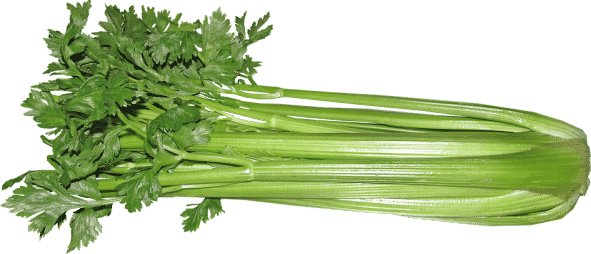 Celery.
Celery. - SOIL AND CLIMATE CONDITIONS FOR CELERY SPICE FARMING: During the growing stage it needs cold climate and during maturing it needs warm climate. A well drained loamy soil is considered good for this herb. The min temperature requirements are 12-30 degree Celsius with an average rainfall of 100 cm. The pH of the soil is maintained at 5.6 for good produce.
- PROPAGATION: propagation is done using seeds which are initially raised in a nursery and then transplanted to the main area.
- LAND PREPARATION AND PLANTING: Land is ploughed four to five times before planting. The spacing of these celery plants is 45 cm x 25 cm and the sowing depth is 2-4 cm. The seeds take 4-8 weeks for seedling and after 2 months, transplanted to the main area. November is the best time for sowing seeds.
- MANURING AND IRRIGATION: FYM @ 20-25 tonnes are used junto com nitrogen @200 kg, phosphorous @100 kg and potash @150 kg per hectare is required. Irrigation is highly essential and is given at an interval of 10-15 days.
- DISEASE MANAGEMENT: Damping –off, Fusarium yellows, early blight downy mildew is controlled by drenching the land with 400 grams of copper Oxy chloride .
- HARVESTING AND PROCESSING: 4-5 months after sowing, the crops are harvested.
- YIELD: one hectare of land yields about 25-30 tonnes of celery.
CUMIN SPICE FARMING:
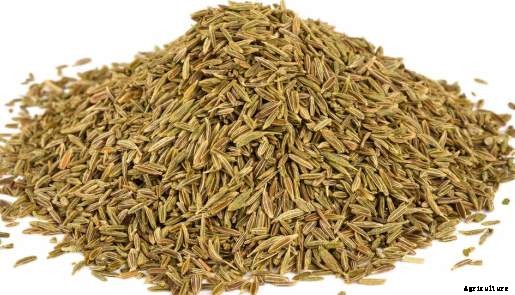 Cumin Seeds.
Cumin Seeds. - INTRODUÇÃO: This is a flowering plant and native to the Middle East and India. Its binomial name is Cuminium Cyminum. Cumin is a herbaceous plant whose seeds is dried and used as spice. The height of this plant is 30-50cm. In Hindi it is addressed as jeera which is most famous and widely used spice in Indian cuisines.
- SOIL AND CLIMATE CONDITIONS FOR CUMIN SPICE FARMING: Sandy loam soil with high nutrient content is required for the cultivation of cumin. The soil should be well drained and should be able to hold moisture. Mild climate is required for its cultivation and winter weather is also suitable. Sunlight is highly essential for its growth.
- PROPAGATION: seeds are used for propagation.
- LAND PREPARATION AND PLANTING: sowing of cumin seeds is done in December and the rows are spaced 30 cm apart.
- MANURING AND IRRIGATION: FYM @ 12-15 tonnes/ha junto com phosphorus @20 kg, nitrogen @30 kg is applied to the soil. These fertilizers are applied in two splits. Initially the seedlings are lightly watered and the second irrigation is done after 7-10 days.
- DISEASE MANAGEMENT: Powdery mildew is controlled by spraying 20-25 grams /10 liters of water. De forma similar, Alternaria blight is controlled by spraying 0.2% of dinocap.
- HARVESTING AND PROCESSING: Complete maturity in plants is obtained within 100-115 days from sowing. Harvesting is done by uprooting the entire plant and drying it. The dried plants are thrashed to remove seeds.
- YIELD: An average yield is 5 quintals per hectare.
GINGER SPICE FARMING:
 Ginger root.
Ginger root. - INTRODUÇÃO: This spice is native to Asia and has high demand locally and internationally. It is an herb which grows to a height of 1 m and bears yellow flowers. This spice has many medicinal properties and refreshing aroma.
- SOIL AND CLIMATE CONDITIONS FOR GINGER SPICE FARMING: Caloroso, humid climate is favorable for the growth of ginger. An altitude of 1400-1500 m is suitable for cultivation. This herb is grown in different soils. The pH of the soil should be 5-6.5.
- PROPAGATION: Propagation is done using rhizomes. The length of the rhizome should be 5-5 cm and should weight 20-25 grams .
- LAND PREPARATION AND PLANTING: 3-4 ploughings of land are done during summer. Crosswise harrowing is done to make the soil loose. A bed for the crops is made 1 m wide, 15 cm high . Each bed is separated by 50 cm. solarisation is done using polyethylene sheets for 40-45 days.
- MANURING AND IRRIGATION: FYM @ 15 tonnes/ha along with NPK @60 kg, 50 kg, 50 kg / ha respectively is used for growing these crops. Irrigation is provided at an interval of 8-10 days. Maximum 20 irrigation cycles are needed for the entire growing period. Drip irrigation is also preferred.
- DISEASE MANAGEMENT: Shoot borer is controlled by spraying 0.1% of Malathion. Rhizome flies are controlled by spraying 05% methyl parathion . Leaf roller and scales are controlled by spraying 0.05% dimethoate . Soft rot is controlled by captafol 0.1%. Leaf spot is controlled by a 1 % Bordeaux mixture . Root knot nematode is controlled by solarising. Bacterial wilt is controlled by spraying 200 ppm streptocycline .
- HARVESTING AND PROCESSING: Green ginger can be harvested in 215-220 days after planting the rhizomes. Yellowing of leaves indicates the harvesting season.
- YIELD: One hectare of land produces 10-15 tonnes of green ginger.
THYME SPICE FARMING:
 Thyme herb.
Thyme herb. - INTRODUÇÃO: This is an evergreen herb with aroma, generally used for cooking and medicinal purposes. It originated from the Europe and spread throughout the world through Romans.
- SOIL AND CLIMATE CONDITIONS FOR THYME SPICE FARMING: Requires well drained, solo fértil. Warm climate is suited for thyme plants and hill regions are considered best for cultivation.
- PROPAGATION: It is propagated through seeds and also vegetatively by plants.
- LAND PREPARATION AND PLANTING: ploughing is highly essential to prepare the land and plants are planted 15-30 cm apart. The spacing between the rows is 60 cm.
- MANURING AND IRRIGATION: FYM @ 50 tonnes/ha, vermicompost @ 5 tonnes/ha, neem cake @1.25 kg/ha, azospirillum and phosphobacterium and panchagavya is sprayed @3%.
- DISEASE MANAGEMENT: No major diseases occur to this plant.
- HARVESTING AND PROCESSING: For cooking purposes leaves and flowers are used. Harvesting starts from 4-5 months of sowing. The shoots are cut from the plant with a length of 15 cm. When the leaves dry, they curl and turn brown.
- YIELD: one hectare of land yield 1100-2200 kg of thyme.
CLOVE SPICE FARMING:
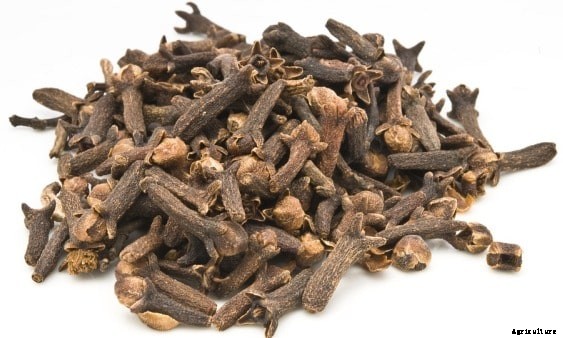 Cloves.
Cloves. - INTRODUÇÃO: Clove is an evergreen tree with high medicinal properties. The binomial name is Eugenia caryophyllus and is native to the Indonesian island. This plant grows to a height of 7-15 m. The dry unopened flower bud of the plant is the clove. In India the Western Ghats are popular for clove cultivation.
- SOIL AND CLIMATE CONDITIONS FOR CLOVE SPICE FARMING: This plant requires a warm, humid climate of temperature 20-30 degree Celsius and an average rainfall of 150-250 cm . The altitude is generally estimated to be 1500 m above mean sea level. Black loamy soil with rich humus is well suited for clove cultivation. Sometimes it is also grown in clay loam and laterite soil.
- PROPAGATION: Seeds are used for the propagation of clove usually during June to October. The seeds are soaked in water before sowing.
- LAND PREPARATION AND PLANTING: Pits of dimensions 60 cm x 75 cm x 3 cm are dug with a spacing of 6-7 m and filled with topsoil. Planting of seeds is done at the end of the monsoon.
- MANURING AND IRRIGATION: Rotten cattle manure @15 kg is required initially, but as the plants grow, they need more manure. The manure is applied basally at a radius of 5 m from the tree. Pot watering is required if there is no sufficient water supply. Plants need subsoil irrigation during peak summer season.
- DISEASE MANAGEMENT:
- HARVESTING AND PROCESSING: yielding starts during 7 years, but to attain full bearing the tree takes 15-20 years . After flowering the buds take 4-6 months for harvesting. The buds are dried for 4-5 days.
- YIELD: One fully grown tree gives 4-8 kg of dried buds.
FENNEL SPICE FARMING:
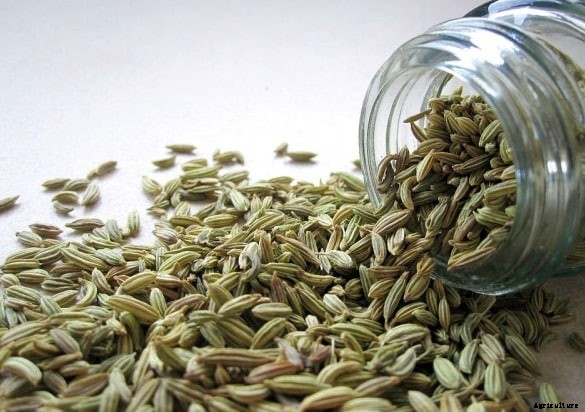 Fennel.
Fennel. - INTRODUÇÃO: It is a flowering plant and native to the Mediterranean. This spice has an exclusive aroma and a different flavor. This herbaceous plant grows to a height of 2.5 m. The binomial name is Foeniculum Vulgare. In India it is addressed as Saunf in Hindi.
- SOIL AND CLIMATE CONDITIONS: Every kind of soil is suitable for the cultivation of fennel. But well drained sandy or loamy soil is best suited with a pH of 6.5-8. The optimum temperature for the cultivation of these crops is 15-25 degree Celsius with an average rainfall of 50-75mm .
- PROPAGATION: It is not a transplanting variety. Propagation is done through seeds directly sowed in the main area.
- LAND PREPARATION AND PLANTING: The land is ploughed two three times to prepare a fine seed bed. This plant is rarely raised in nurseries. Sowing is done during October and if it is a rain fed region, then spacing of 45 cm between rows with 10 cm crop spacing is maintained.
- MANURING AND IRRIGATION: Cow dung@4-6qtl/acre along with urea@45 kg/acre i s applied three times in equally split proportions. Pre-sowing irrigation is done and then at an interval of 10-15 days 10-12 cycles of irrigation is required during the entire duration of cropping.
- DISEASE MANAGEMENT: Aphids are controlled by spraying 0.03% of dimethoate . Seed midge and heliothis is controlled by spraying 0.07% of endosulphan .
- HARVESTING AND PROCESSING: Maturity of plants is known when seeds are full and green in color. The umbels are cut and dried in the sun for 2 days and then dried in the shade for 10 days. The crop harvesting is done in May i.e. after 180 days from sowing.
- YIELD:O ne hectare of land yields 10-11 quintals of fennel on an average.
BLACK PEPPER SPICE FARMING:
 Black Pepper.
Black Pepper. - INTRODUÇÃO: The binomial name of black pepper is ‘piper nigrum’ and it is an evergreen flowering vine. This plant in mostly found in south India and grows to a height of 10 m. This is the earliest form of spice in India. There are 75 cultivars of pepper in India of which Karimunda is most popular. Other varieties are kottanadan, narayakkodi, aimpiriyan, kuthiravally, balancotta, kalluvally, malligesara and uddagare.
- SOIL AND CLIMATE CONDITIONS FOR BLACK PEPPER SPICE FARMING: pepper plants require tropical humid climate with sufficient rainfall (125-200 cm). The submountaeous region of Western Ghats is exclusive for growth of pepper plants. Clay loam, red loam and lateritic soils are suitable for pepper farming. The pH value of the soil is maintained at 4.5-6.0. The temperature should be in between 10-40 degree Celsius.
- PROPAGATION: Cutting from runner shoots is used for propagation of pepper. One third of the root is cut and planted in the nursery. They are obtained in the month of February –March. Roots develop from the cuttings and they are set for planting.
- LAND PREPARATION AND PLANTING: level land with proper drainage is chosen for farming. South facing slopes are avoided, but north or north eastern slopes are preferred to avoid the effect of the sun. Planting is done in the monsoon. Square pits of dimensions 0.5 m x 0.5 m are dug and the spacing between the pits is 2.5 m x 2.5 m . Seedlings which are two years old are planted in the pits. When the vine grows, it is initially made to creep on a pole of 2 m height. After a certain length the temporary stake is removed and planted in a trench of depth and width equal to 15 cm close to the tree trunk.
- MANURING AND IRRIGATION: Rotten cattle manure@ 10 kg is used as manure for pepper plants. 100 grams of nitrogen, 40 grams of P2O5 and 140 grams of K2O is used as a fertilizer for three year old plants. 1/3
rd
of the above mentioned composition is applied in the first year and 2/3rd of the quantity is applied in the second year. Lime @500 grams is applied as fertilizer during later stages of development.
- HARVESTING AND PROCESSING: Yield starts after 3 or 4 years from planting. The ripening takes 6-8 months from flowering and harvesting is done during November till February. The entire spike is plucked when the berries turn bright red. The spike is rubbed with hands to remove the berries which are then dried in the sun for 7 to 10 days until the berries turn black.
- YIELD: 800-1000 kg of black pepper is obtained from one hectare of plantation land (7-8 yrs old). The yield reduces after every 20-25 years.
CINNAMON SPICE FARMING:
 Cinnamon spice.
Cinnamon spice. - INTRODUÇÃO: Cinnamon is the inner bark of the tree and is the first known spice with rich flavour. It is native to Sri Lanka. Also lower slopes of Western Ghats (Kerala and Tamilnadu) cinnamon cultivation are predominant. Binomial name is Cinnamomum Cassia.
- SOIL AND CLIMATE CONDITIONS FOR CINNAMON SPICE FARMING: lateritic and sandy soil is preferred for cinnamon plant. The elevation of land above sea level is approximately 1000 m . This plant requires an annual rainfall of 200-250 cm .
- PROPAGATION :Cinnamon is propagated by rooted cuttings, air layering and seeds. 10 cm long with 2 leaves semi hardwood cuttings are dipped in keradix-B and planted in a polythene bag consisting of sand and coir dust mixture in the ratio 1:1. These are watered twice in a day and stored in the shade. Depois de 45-60 days the roots develop indicating that it can be transplanted to a another permanent place
- A ring from the semi hardwood bark is removed and IBA 2000 ppm is applied on it. This region is covered with coir husk and wrapped with 20 cm of polythene. Rooting starts after 40-60 days and the air layers are detached from the parent plant. These can be planted in the main area during monsoon
- For the sowing of seeds a mixture of sand, soil and rotten cattle manure in the ratio 3:3:1 is prepared and germination starts after 15 -20 days. Moisture is a must for these plants.
- LAND PREPARATION AND PLANTING: Pits of dimensions 50 cm x 50 cm x 50 cm are dug with space between each pit being 3m x 3m. The pit is initially filled with topsoil and compost and the seedling are planted. One acre land can accommodate 3600 pits
- MANURING AND IRRIGATION: 20 grams of nitrogen, 18 grams of P2O5 and 25 grams of K2O are used as fertilizer in the initial growth period. The dose increases with the age of the plants. Fertilizers are applied during may-June and September-October. Green leaves are used for mulching FYM @25 kg i s applied in May-June. Irrigation is essential during summer.
- DISEASE MANAGEMENT: Colletotrichum Gloeosporioides causes leaf spotting and die back disease. Diplodia sp. causes seedling blight. Pestalotia palmarum causes grey blight. All these are controlled by a 1 % Bordeaux mixture . Pests like leaf minor and cinnamon butterfly are controlled by the use of quinalphos (0.05%).
- HARVESTING AND PROCESSING: When the tree is grown to a height of 10-15 m in 4 years, shoots are available for peeling. Coppicing is done to encourage regrowth. Shoots of thickness 5-2 cm are chosen for the extraction of barks. 1-1.25 m of shoots are cut into straight pieces followed by scraping and peeling. The peels are dried in the shade and then in sunlight for 4 days. Dried barks take the shape of a quill. Grading of quills is done from 00000, 0 being the most coarse quality. Small bark pieces are called quillings; thin inner pieces are called featherings.
- Distillation of dried cinnamon leaves and barks produces oils. This oil is used in soaps, perfumes, cremes, toothpastes etc.
- CULTIVARS AND YIELD: Two varieties are known in India, the Navashree and the Nithyashree. 56 and 54 kg of dry quills /ha /yr are obtained from Navashree and Nithyashree respectively. The product yield of Navashree is such that 2.7% bark oil, 73% cinnamaldehyde 8% oleoresin 2.8% leaf oil, 62% leaf eugenol. The product yield of Nithyashree is (2.7% bark oil, 58% cinnamaldehyde, 10% oleoresin, 3% leaf oil and 78% eugenol.
Read about Zero Budget Natural Farming.
Read about Hydroponic Growing System.





















